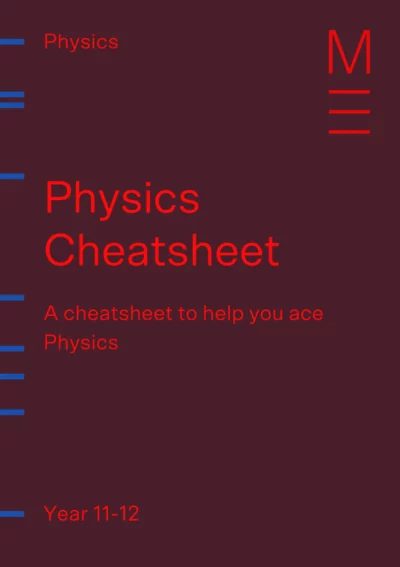Welcome to Matrix Education
To ensure we are showing you the most relevant content, please select your location below.
Select a year to see courses
Learn online or on-campus during the term or school holidays
Learn online or on-campus during the term or school holidays
Learn online or on-campus during the term or school holidays
Learn online or on-campus during the term or school holidays
Learn online or on-campus during the term or school holidays
Learn online or on-campus during the term or school holidays
Learn online or on-campus during the term or school holidays
Get HSC exam ready in just a week
Select a year to see available courses
Science guides to help you get ahead
Science guides to help you get ahead
Boost your HSC Physics marks by making the most of the HSC Physics formula sheet. Here are 5 essential tips to use it smarter and faster.

Join 75,893 students who already have a head start.
"*" indicates required fields
You might also like
Related courses
The HSC Physics formula sheet is one of the most valuable tools you have in Year 12 Phsyics exams. It contains key equations covering motion, forces, waves, thermodynamics, electricity, magnetism, quantum mechanics, relativity, and nuclear physics.
You don’t have to waste valuable brain space memorising formulas. That’s how scientists work; they look up formulas when needed and save their thinking for solving new problems!
Get the competitive edge for your next Physics assessment! Fill out your details below to get this resource emailed to you. "*" indicates required fields
Download your FREE foldable Physics Cheatsheet

Download your FREE foldable Physics Cheatsheet
But you need to know how to use them effectively and efficiently. Think of the formula sheet like a toolbox: If you don’t know which tool to pick or how to use it properly, you could easily make mistakes.
Here are five expert tips to help you make the most of your formula sheet during the HSC Physics exam:
The formula sheet includes a lot of information—but there are no labels explaining what the symbols mean or what each formula is for! You might have added notes while studying, but you won’t have access to them in the exam.
Test yourself:
Print a blank copy of the formula sheet and write next to each formula what it calculates and when to use it.
For example:
\(B = \frac{\mu_0 I}{2 \pi r}\) versus \(B = \frac{\mu_0 N I}{L}\)?
\(U = mgh\) and when to use \(U = -\frac{GMm}{r}\)?
Tip: Some symbols, like \(\lambda\), can mean different things in different equations (e.g., wavelength or decay constant). Always check the context before plugging in numbers.

Many Year 12 HSC questions require you to combine multiple formulas to reach the final answer. Recognising how formulas connect will save time and reduce errors.
For example, when solving a projectile motion question:
Other examples of formula combinations:
Tip: Practise “show” questions to get a feel for which equations can be combined.
In exams, you’ll often need to solve for variables that aren’t already isolated. Rearranging equations before plugging in numbers reduces mistakes.
Examples:
Given power (P) and resistance (R), asked for current (I):
Start with \(P = I^2 R\),
rearrange to \(I = \sqrt{\frac{P}{R}}\).
Asked for acceleration (a) in kinematics:
Start with \(v^2 = u^2 + 2as\),
rearrange to \(a = \frac{v^2 – u^2}{2s}\).
Tip: Get comfortable with algebra. Rearrange first, then substitute numbers.
Your formula sheet also includes important constants like the speed of light, Planck’s constant, and Earth’s radius. Some questions won’t explicitly give you these values—you’ll need to know when to apply them.
Examples:
Given a radio wave’s wavelength, you’ll need to remember its speed equals the speed of light to use the wave equation,
\(v = f\lambda\).
When calculating gravitational potential energy of an orbiting satellite, don’t forget to add the satellite’s altitude to Earth’s radius in:
\(U = -\frac{GMm}{r}\).
Tip: While revising, make a list next to your data sheet of past questions where you’ve used each constant. This helps you spot when they’re needed.
Both sides of an equation must have matching units. Using SI units makes life easier and ensures your answers are correct.
Remember:
Tip: Always write units when listing variables. It forces you to double-check conversions and prevents careless mistakes.
The formula sheet is your secret weapon—but only if you know how to use it well. You can solve problems faster and more accurately, if you;
Practise using the formula sheet under timed conditions before your exam. That way, it feels natural, and you’ll stay calm and focused on the day.
Get the competitive edge for your next Physics assessment! Fill out your details below to get this resource emailed to you. "*" indicates required fields
Download your FREE foldable Physics Cheatsheet

Download your FREE foldable Physics Cheatsheet
Written by Matrix Science Team
The Matrix Science Team are teachers and tutors with a passion for Science and a dedication to seeing Matrix Students achieving their academic goals.© Matrix Education and www.matrix.edu.au, 2023. Unauthorised use and/or duplication of this material without express and written permission from this site’s author and/or owner is strictly prohibited. Excerpts and links may be used, provided that full and clear credit is given to Matrix Education and www.matrix.edu.au with appropriate and specific direction to the original content.